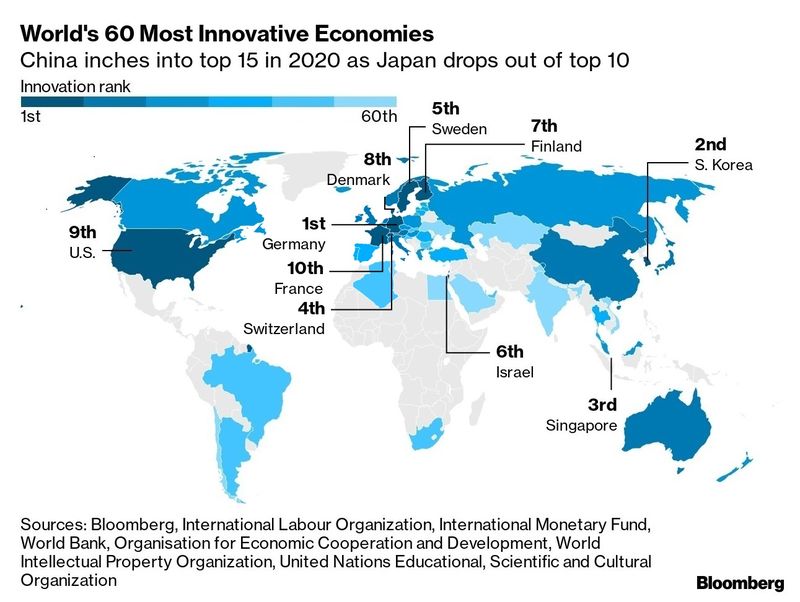What makes a country a potential innovation (R&D)?
I would like to share with you the eighth installment of the Bloom Bloomberg 2020 Innovation Index, where Germany and South Korea took the top two places in the ranking. This means that both nations have the most capacity to innovate, because they include significant research and development expenses, manufacturing capacity and concentration of high-tech public companies in their development programs.
Germany ranked first breaking South Korea’s six-year winning streak, while the United States fell one level to No. 9. Germany earned three rankings in the top five in value-added manufacturing , high technology density and patent activity. This Index values issues such as patent registration, investment in education or productivity.
We can see that Spanish-speaking countries are not very well placed in the ranking, since Spain appears in 33rd place, and Latin America is Argentina who appears in 45th place followed by Chile in 51st place.
The limited loss of South Korea is not a reason to anticipate a breakdown in its innovative skills. R&D spending “determines the life or death of South Korean companies,” with technology-oriented heavyweights such as Samsung Electronics Co., LG Electronics Inc. and Hyundai Motor Co. leading the economy.
Singapore’s rise to third place overall, since the sixth year, was aided by productivity and value-added manufacturing gains, while maintaining the best global ranking in tertiary education efficiency.
The news is less optimistic for the main advanced economies. The United States, which was number 1 when the Bloomberg Index debuted in 2013, dropped one place to number 9 since last year’s standings. Japan fell to number 12, three points below the same size in last year’s index.
The second largest economy in the world, China, exceeded number 15 in one place. It remained in second place in patent activity, and entered the top five in tertiary efficiency.
At least, the United States can celebrate holding on to world performance in two categories: high-tech density and patent activity. Among the 20 publicly traded companies with the highest research and development expenses in their last fiscal years, half were from the US. UU., Led by Amazon.com Inc., Alphabet Inc. and Microsoft Corp. Germany was second with four: Volkswagen AG, Daimler AG, Siemens AG and Bayer AG.

What is the Global Innovation Index?
The list presented is finally reduced to the 60 most innovative nations – scored from 0 to 100 – from among the 95 that met the requirements, eliminating those that did not provide data from at least six of the seven main categories on which it is based This innovation ranking:
1. Investment in R&D
Percentage of the Gross Domestic Product —PIB— of a country dedicated to Research and Development. South Korea imposes itself in this category by allocating 4.3% of its GDP – almost $ 70 billion.
2. Patent registration
Number of patents registered internationally. The United States continues to be the leader due to its powerful technology industry, where the registration of patents related to Artificial Intelligence (AI) is growing.
3. Investment in higher education
It refers to the educational level of workers, specifically those who reach university, postgraduate and doctoral studies. Singapore is in the lead by investing 20% of its annual budget. In contrast, the United States barely spends 2%.
4. Value added in the industry
The United States Office of Economic Analysis defines added value as “the contribution of private industry or the public sector to global GDP.” According to Bloomberg this section would be led by Ireland.
5. Productivity
Ireland also dominates this category thanks to what the Nobel Prize in Economics, Paul Krugman, defined as leprechaun economics – economy of goblins – after the strong increase in the country’s GDP as a result of the massive landing of multinational companies.
6. Density of high-tech public companies
It includes companies dedicated to computer science, biotechnology, electronics, etc. In this section, the United States is the undisputed leader as it is the headquarters of the most important technology companies in the world.
7. Concentration of researchers
Science and engineering professionals – including doctoral students – by number of inhabitants. The scepter is held by Denmark, where about one fifth of its research is cited in 10% of the most important publications of OECD countries.

Boosting innovation in Latin America
Innovation is complex, many factors play a role in the ideation, development and commercialization of any new technology. And while the success of innovation can boost economic growth, it is generally more accessible in high-income economies, where R&D financing is readily available. Nevertheless; Latin American countries should not lose faith, because there is a lot of human talent and potential for creativity, in this way they can improve their productivity levels and, thus, achieve inclusive and sustained growth.
“Through creativity and innovation, great changes can be achieved. We have to take the good practices of the creative industries and transfer them to the traditional ones”
Innovation is essential to boost business ecosystems that contribute to increased productivity and sustained growth in the medium and long term. And to boost it, it is necessary to generate great political consensus that includes all the social sectors and that promotes efficient and independent measures of the political conjunctures of the countries.
DO YOU WANT TO COMMENT?
